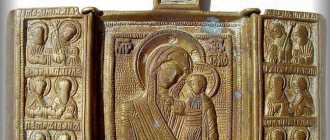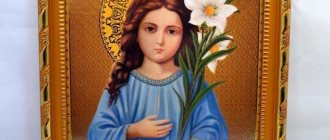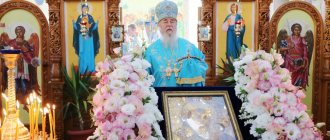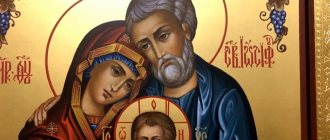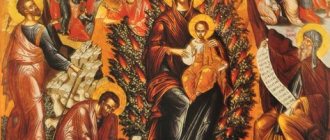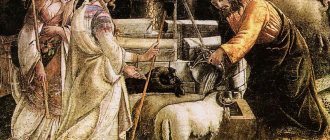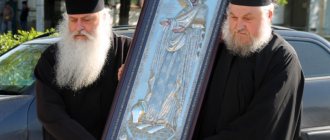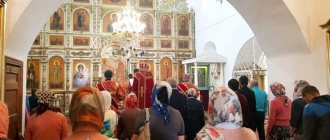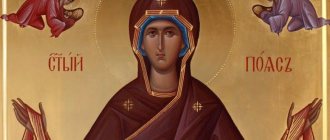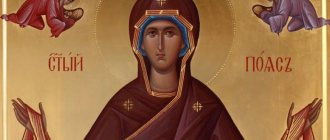The images of the Mother of God are surprisingly diverse. The Queen of Heaven appears before us, now spiritualized and majestic, now tender and affectionate, now slightly reproaching and calling for a righteous life. But we are all accustomed to the fact that on icons the Ever-Virgin is depicted with her divine offspring.
The icon “Joy of all Joys” (or “Tenderness”) destroys stereotypes, because it depicts the Mother of God alone. This is not surprising: an unknown icon painter captured a touching moment when she just received the good news that she would have a divine son.
The meaning of the icon “Joy of all joys”, what does the image help with?
The meaning of the image “Joy of all joys” for all Orthodox Christians is enormous. He is an example of Christian humility, selfless service to God and the joy of true faith.
They pray to this icon for many things, in particular:
- Healing from illnesses. Most of the miracles performed in this way are associated with the healing of the sick. Many of them are documented.
- Conceiving a child and successfully delivering the pregnancy. Childless couples and pregnant women often come to the miraculous image. After sincere prayer, many achieve what they want!
- Purity and happiness in personal life. It is believed that Mary gives girls who pray in front of the miraculous image the strength to remain pure even in our time and helps in finding a worthy spouse.
- Instructing children. Usually parents whose children are going through difficult adolescence turn to the icon. They say that Maria also helps young people who have become involved with bad company and suffer from addictions.
- Reconciliation. The miraculous icon promotes wisdom and helps to find a path to reconciliation with both loved ones and old enemies.
Seraphim of Sarov never parted with the miraculous image: even during his travels, he carried it with him in his bag. You can follow his example, wear the Tenderness icon in a pendant or bracelet and remain under the constant protection of the Mother of God.
Origin story
This image belongs to the newly painted. This is the name given to icons created by our contemporaries. The author's name is not mentioned. The only thing known about the origin of the face is that Archimandrite Theophylact (Bezukladnikov), the rector of the New Jerusalem Monastery, presented the image as a gift to Patriarch Kirill at the solemn service of the consecration of the Resurrection Cathedral, at its opening after restoration work.
Despite the fact that the icon is in the monastery, free access to it is open to all believers at all times. Worship services are held every week. Also, the monastery organizes excursions, including an introduction to the face of the Joy of All Angels.
- Icon of the Mother of God Joy of All Angels in the iconostasis of the Resurrection Cathedral of the New Jerusalem Monastery (Istra, Moscow region).
Iconography and meaning
The Most Holy Theotokos is depicted in full height. Her long black robe is embroidered with ornate gold patterns. The head and shoulders are covered with red maforium with elegant trim around the edge.
Angels hold the royal crown on Her head. Around her, a halo of regular round shape shines with golden rays. The feet of the Mother of God stand on a crescent moon, with its horns pointing upward. These are ancient AllatRa symbols, revealing the human essence of personality and soul, which are subordinate to the dual principle - human and spiritual.
- An ancient AllatRa sign used on Christian icons.
In canonical iconography, this symbol was used quite rarely. The meaning put into it is described in the AllatRa book:
“The circle is a symbol of the Soul, as well as one of the symbols of the manifestation of a spiritual Being from the world of God. And the symbolic sign of a crescent with its horns up is a symbol of a person who was spiritually liberated during his lifetime. The AllatRa sign was also used to designate one who came from the spiritual world (other, higher) to this material world, updating the lost primordial Knowledge ».
This symbol is often interpreted as a sign of “those walking the spiritual path.”
Icons depicting a circle and a crescent have not only a protective and intercessory meaning, but are also a gift of spiritual transformation on the temporary earthly path to eternal life.
In confirmation of this, the New Jerusalem Monastery is depicted at the bottom of the icon, which symbolizes the only correct connection between earthly man and believer, the Kingdom of Heaven, depicted in the form of clouds around the Mother of God and Her Son.
- Icon of the Mother of God Joy of All Angels.
The Most Holy Theotokos holds Her Child in her arms, hugging Him with both hands. Thus, the Most Holy Mother of God protects not only Her Child, but also all people, interceding for them before the Lord God. She is helped in this by the angels who surround the Mother of God and the Baby Jesus.
The Son of God touches the Mother with one hand and holds an orb in the other - a round ball with a crown and a cross. It is a symbol of spiritual dominion over the entire world.
Like the Mother, the Baby Jesus has a crown on his head. Together with the orb, it personifies the spiritual power of Christ over people.
One of the meanings put into the symbolism of the icon is expressed in the crescent, which in Scripture is associated with the end of the world: “And the moon is under Her feet.” The month that appears at night is associated with the dark, earthly origin of man, and the shining sun above the clouds and the head of the Virgin Mary and Her son is the bright path to the Kingdom of Heaven.
This icon is a reminder to Christians that not everyone will be able to get into “eternal life,” but only those who have received spiritual enlightenment on the earthly path.
Based on the type of iconography, the image of the Mother of God, the Joy of All Angels, is compared with the face of the Most Holy Theotokos “Gracious Sky.” He, in turn, belongs to the “akathist” icons that glorify the Queen of Heaven.
Here the standing figure of the Blessed Virgin is depicted in full height. Her dark clothes are decorated with golden borders. On Her head is a Royal crown.
The Mother of God hugs Her Son with both hands. Baby Jesus is dressed in a colorful long robe. Mother and son are surrounded by sunlight, which icon painters call mandola.
The image was created using bright, contrasting colors. This is a sparkling halo, crowns on the heads of the Blessed Virgin Mary and Jesus, gold trim on Her dark robe. Such a technique attracts the eye and evokes reverence.
- Icon of the Mother of God of Gracious Heaven.
The image is distinguished by its versatility and complexity of composition. A legend has been preserved that the Queen of Heaven is depicted as she will be at the time of the second coming of Christ, since her face with its entire appearance expresses a prayer for the salvation of the world. This is how theologians interpret the hidden meaning of the icon, where the Mother of God symbolizes the Church of Christ.
According to icon painters, the type of depiction of this icon belongs to the Western European direction. It originated in the 15th century. This style entered Russian church painting in the 17th century, passing through Poland, Lithuania, Belarus, and Ukraine. The most famous icons of this type are “Burning Bath” and “Sunny”.
This iconographic style is characterized by the following features:
- Mother of God with the Child in her arms,
- The shining halo surrounding them is oval in shape,
- The obligatory presence of a plot from an akathist, in which there are kneeling saints or angels soaring in heaven,
- An individual way of connecting image elements that is clearly distinguishable from others. You can easily recognize icons of the akathist type from them.
When it comes to the icon of the Mother of God of the Blessed Heaven, as a rule, they always mention that its prototype, most likely, was the image of an earlier historical period - “The Woman Clothed in the Sun.”
- Icon of the Mother of God, Woman Clothed in the Sun.
The Virgin Mary is depicted in full height. In her arms is the Baby Jesus. Legs Her legs are on a crescent-shaped crescent, with the ends turned upward. A golden glow, a mandorla-halo, shines around the figures of the Mother and Son. The head of the Virgin Mary is crowned with a royal crown. There is a similar one on the head of little Christ.
This image is an illustration of words from the Apocalypse:
“And a great sign appeared in heaven: a woman clothed with the sun; under her feet is the moon, and on her head is a crown of twelve stars... And she gave birth to a male child, who is to rule all nations with a rod of iron” (Tk. 12:1,5).
The Mother of God is called clothed in the sun in the akathist to the Dormition of the Most Holy Theotokos (kontakion 1): “Rejoice, clothed in the sun, shining with grace and glory throughout the entire universe.”
Images of this type are typical for ancient engravings, sculptures, and stained glass windows of Catholic churches in the period starting from the 15th century.
Thus, if you look closely at the icons of the Joy of All Angels, the Blessed Heaven and the Woman Clothed in the Sun, you can find a lot in common.
When is the holiday of the icon celebrated?
The day of honoring the miraculous image falls on August 10. These days, the icon is taken out during the procession, and anyone can pay homage to it.
There is another permanent holiday, almost directly connected with this icon. This is December 22: this day is considered the date of the founding of the Diveyevo monastery by the same Venerable Seraphim, thanks to whom “The Joy of all Joys” became known.
Trinity Seraphim-Diveevo Monastery
Where to hang
In the house, the icon of the Mother of God can be placed in the iconostasis or kept separately. The main thing is that it should be clearly visible and create free access to it. The image can be hung in any room where there is an opportunity for privacy and focus on sincere prayer.
According to church rules, it is better to place the icon on the eastern wall. If this is not possible, then it is located in the right corner of the door. In cases where it is not possible to place the face there, it is quite acceptable to hang it or place it in another place where nothing will interfere with the prayer.
This means that there should be no objects near the icon that prevent you from concentrating on a spiritual conversation with the Lord. These are all kinds of paintings, posters, souvenirs, sculptures and other interior decor. If these things cannot be rearranged, then it is necessary to provide for the possibility of covering them during prayer.
Since candles must be lit in front of the icon, the place where it is located must be protected from open fire.
Lists icons
In the 18th-19th centuries, many copies of the “Joy of all Joys” were made, some of them received a piece of the miraculous properties of the original - then this image was revered in every possible way. However, during the revolution and over many decades of godlessness, almost all lists were lost.
The most famous list at the moment is expectedly located in the Diveyevo Monastery. This is, so to speak, a remake, but it has already achieved miracles.
In addition to the actual lists of “The Joy of All Joys,” there are many images of Seraphim of Sarov. On many of them he is depicted kneeling in prayer before the “Tenderness”.
How to pray to an icon correctly
You can pray to the miraculous image both in the temple and at home, in front of the family iconostasis. And you can also turn to the images on consecrated jewelry, and at any moment when you need support and help.
The Queen of Heaven is all-merciful and all-forgiving; she intercedes for us before the Savior. Therefore, one should offer prayer with respect, with the utmost seriousness and concentration, without being distracted by other thoughts and matters.
Before prayer, it is advisable to clean the room, light a lamp or candle and read the “Our Father”. Then you can turn to the Heavenly Intercessor.
There are many prayers to the Mother of God that can be read before this image. However, there are troparia, akathists and prayers addressed directly to the “Joy of all Joys.”
Text of the prayer to the icon “Joy of all Joys”
About the Lady Theotokos, the delight of my soul, the divine stream of my withered heart, the bright lamp of my darkened mind, the guide of my lazy will, the strength of my weakness, the endowment of nakedness, the wealth of poverty, powerful and quick healing of incurable wounds, the drying of tears, the quenching of sobs, the transformation of troubles , relief from illnesses, resolution of bonds, hope of salvation! Hear my prayer: give me time of repentance, zeal for salvation, strength in the labors of pleasing God: save me from misfortunes and all kinds of evils, in temptation and troubles extend Your helping hand, so that I may rise in the fall and not perish in cruelty. Dondezh I remain in this much-painful life, do not deprive me of the gifts of Your mercy. Grant Thy goodness to all the Christ-loving brethren standing here and praying. Raise the infants, guide the young, support the old, comfort the faint-hearted, bring the erring to reason, look upon and protect the widows and the orphans, pour out Your rich mercy on all those who love and hate us. And at the end of my life, at the time of my exodus from my body, be my Intercessor: soften mortal illness, quench melancholy and lead my poor soul to the eternal abode, so that the dark force does not take me, let it drag me down into the depths of hell. to her, Offering the Lady Theotokos, Tenderness to my soul! Warm my heart, cold in faith and love, with tears of tenderness; For the prayers of our venerable father Seraphim, Your honorer, bestow upon me, the one who grieves and is burdened with sins, the necessary joy and consolation. May I not, O Bride of God, be deprived of the hope of my fruit, but may I be granted this acceptance in God and my Savior, Thy beloved Son, our Lord Jesus Christ. To him be glory and power, honor and worship, with his Beginningless Father, and his All-Holy and Good and Life-giving Spirit, now and ever and unto ages of ages. Amen.
You can pray to the Mother of God not only in the canonical text, but also in your own words, expressing your deepest desires. If the thoughts of the person praying are pure and the heart is filled with faith, the Mother of God will definitely hear the message addressed to her!
02.09.21
Prayers to the Holy Mother of God
O Most Holy Virgin, Mother of the Most High Lord, Intercessor and Protection of all who come to You! Look from the heights of your saint at me, a sinner (name), fallen in your purest image; hear my warm prayer and bring it to your beloved Son, our Lord Jesus Christ; pray that he will enlighten my dark soul with the light of his divine grace, may he deliver me from all want, pain and illness, may he send me a quiet and peaceful life, physical and mental health, may he pacify my aching heart and heal its wounds, may he will guide me in good deeds, my mind must cleanse me from vain thoughts, teach me to fulfill his commandments and save me from eternal torment, and not deprive me of His Kingdom of Heaven. O Most Holy Theotokos! You, “Joy of all who mourn,” listen to me, the mourner; You, called Pain Satisfaction, soothe my pain; You, “Burning Kupino”, save the world and all of us from the harmful fiery arrows of the enemy; You, “seekers of the lost,” do not allow me to perish in the abyss of my sins. Bose is my hope and hope. Wake me up for temporary life, an intercessor, and for eternal life before Your beloved Son, our Lord Jesus Christ, an intercessor. Teach me to serve You with faith and love, and You, Most Holy Theotokos, Most Holy Mary, honor me reverently until the end of my days. Amen.
